Shoulder Active Range of Motion Exercises
Medically reviewed by Yaw Boachie-Adjei, MDFact checked by Nick Blackmer
Shoulder active range of motion (ROM) exercises may be prescribed for you if you have a shoulder condition that causes limited mobility in your shoulder and arm. These exercises are active—they are done by you, using your own muscle strength and power with no external help. This helps to improve overall muscular function and strength around your shoulder, which can help you fully recover after shoulder surgery or a shoulder or elbow injury.
If you have shoulder pain, you may benefit from physical therapy to ease painful symptoms and improve your shoulder strength and range of motion (ROM) so that you can return to normal function.
Your physical therapist should work with you to perform shoulder special tests and help determine the cause of your shoulder pain. A ROM loss around your shoulder joint is a common finding in people with shoulder pain. Also, you may have decreased shoulder ROM if you have had shoulder surgery like a rotator cuff or labrum repair.
Your physical therapist will help to progress you through a safe and effective exercise program to help you restore normal ROM in your shoulder. The typical progression to restore normal, pain-free ROM to your shoulder begins with passive ROM. Shoulder pulleys can be used to help regain passive ROM. Once passive ROM is restored, you may progress to performing active-assistive ROM exercises, and finally, active ROM exercises like the ones in this program.
The exercises in this step-by-step guide are meant to help you restore the active ROM to your shoulder.
Takeaway
You must first check with your healthcare provider or physical therapist to ensure that these exercises are safe and appropriate for you to perform. If any of these exercises cause pain, you should stop immediately and consult with your healthcare provider.
Shoulder Abduction Exercise in Sidelying
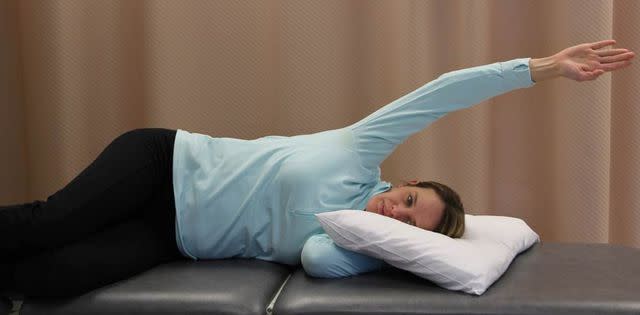
To begin the shoulder active ROM exercises, start with active shoulder abduction. Lie on one side. The shoulder that you are exercising should be on top. Keep your elbow straight and your thumb pointing towards the ceiling.
Once your arm is straight and resting on your hip, slowly lift your arm up into the air and towards the ceiling. Be sure to keep your arm in line with your body, and make sure your thumb remains pointing at the ceiling.
Move your shoulder fully through a pain-free ROM, and then slowly lower your arm back down to the starting position. Perform 8 to 12 repetitions of this exercise, and then progress to the next exercise.
Takeaway
Be sure to stop if you feel worsening pain in your shoulder or arm.
Active Horizontal Abduction Exercise
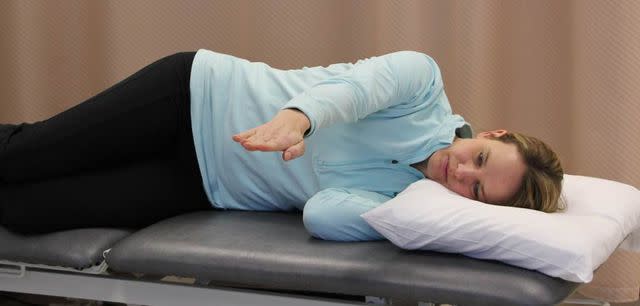
The next shoulder active ROM exercise is called horizontal abduction. Start this exercise by lying on your side with the shoulder to be exercised on the top.
Keep your elbow straight and flex your shoulder so that your arm is out in front of you and parallel to the floor.
Slowly lift your arm up so that your hand is pointing towards the ceiling. Hold this position for one to two seconds, and then slowly lower to the starting position. Move through a pain-free ROM.
This exercise should be performed for 8 to 12 repetitions. If you experience any pain with this exercise, stop immediately and consult your healthcare provider or physical therapist.
After this exercise is complete, you can move to the next exercise: active shoulder external rotation.
Sidelying Shoulder External Rotation Exercise
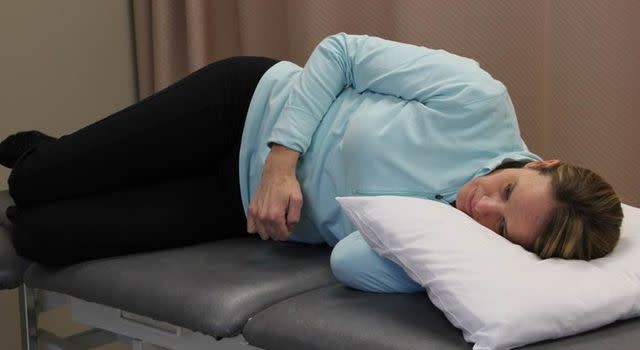
Active shoulder external rotation is an excellent exercise to improve the use of your rotator cuff muscles. This exercise is very effective to perform after rotator cuff surgery or a shoulder injury. It can help improve rotator cuff strength or improve neuromuscular control of this muscle group. Be sure to talk to your healthcare provider and physical therapist to ensure that this exercise is appropriate for you.
To start this exercise, lie on your side with the shoulder to be exercised on top. Keep your elbow bent to 90 degrees and tucked into your side. Your elbow should remain at your side the entire time. Your hand should be resting comfortably in front of your navel.
Active Shoulder External Rotation

To perform the active external rotation, slowly raise your hand up towards the ceiling. Your elbow should remain bent and stay tucked into your side. The motion should be coming from your shoulder as it rotates. When your shoulder rotates out all the way, hold the end position for two seconds, and then slowly return to the starting position.
You should perform 8 to 12 pain-free repetitions of this exercise. Then, progress to the final shoulder active ROM exercise.
Sidelying Shoulder Internal Rotation Exercise
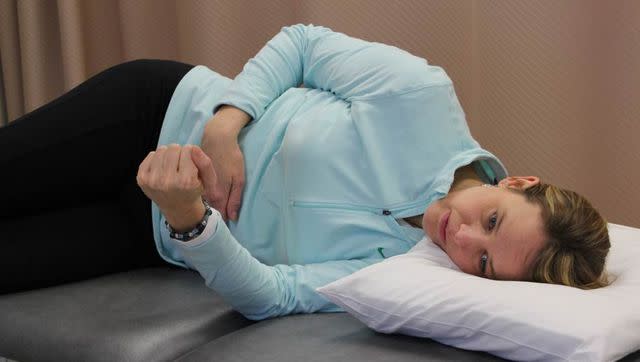
To start active shoulder internal rotation, you must lie on your side, but this time your shoulder to be exercised should be on the bottom. You may have to move your arm forward an inch or two so that you are not lying directly on your arm or elbow.
Keep your elbow bent to 90 degrees, and keep your palm facing up.
Shoulder Internal Rotation Exercise
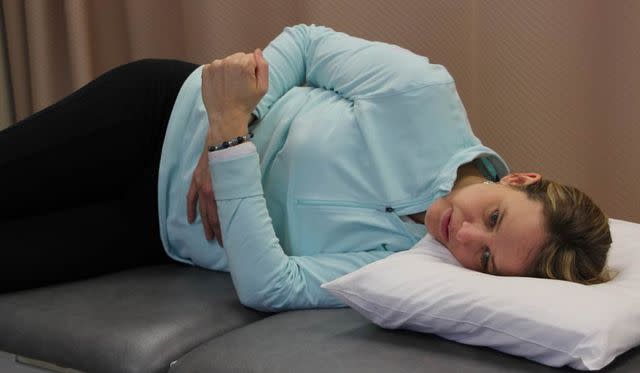
While keeping your elbow bent to 90 degrees, slowly rotate your shoulder so that your hand moves up towards your navel. The ROM should be pain-free. Once your hand is up at your navel, hold this position for two seconds, and then slowly lower back to the starting position.
Repeat this exercise for 8 to 12 repetitions. Be sure that no pain is caused by this exercise.
The four exercises in this step-by-step guide are meant to help improve the active range of motion around your shoulder. Once these exercises become easy, you may wish to progress to shoulder and rotator cuff strengthening exercises by performing these exercises with free weights. Rotator cuff strengthening exercises with resistance bands are also a great way to strengthen your shoulder. Again, your healthcare provider or physical therapist can help you decide the safest way to progress with your shoulder-exercise program.
A Word From Verywell
Starting active ROM exercises is a great way to improve the overall muscular function around your rotator cuff and arm. If you have had shoulder surgery or have an upper extremity injury, check in with your physical therapist and get started on active shoulder motion exercises.
Read the original article on Verywell Health.

